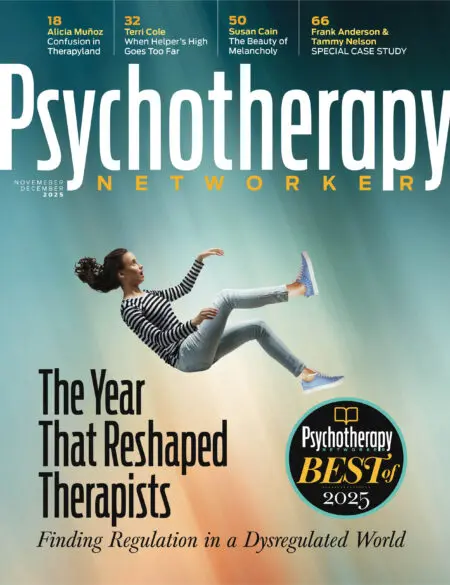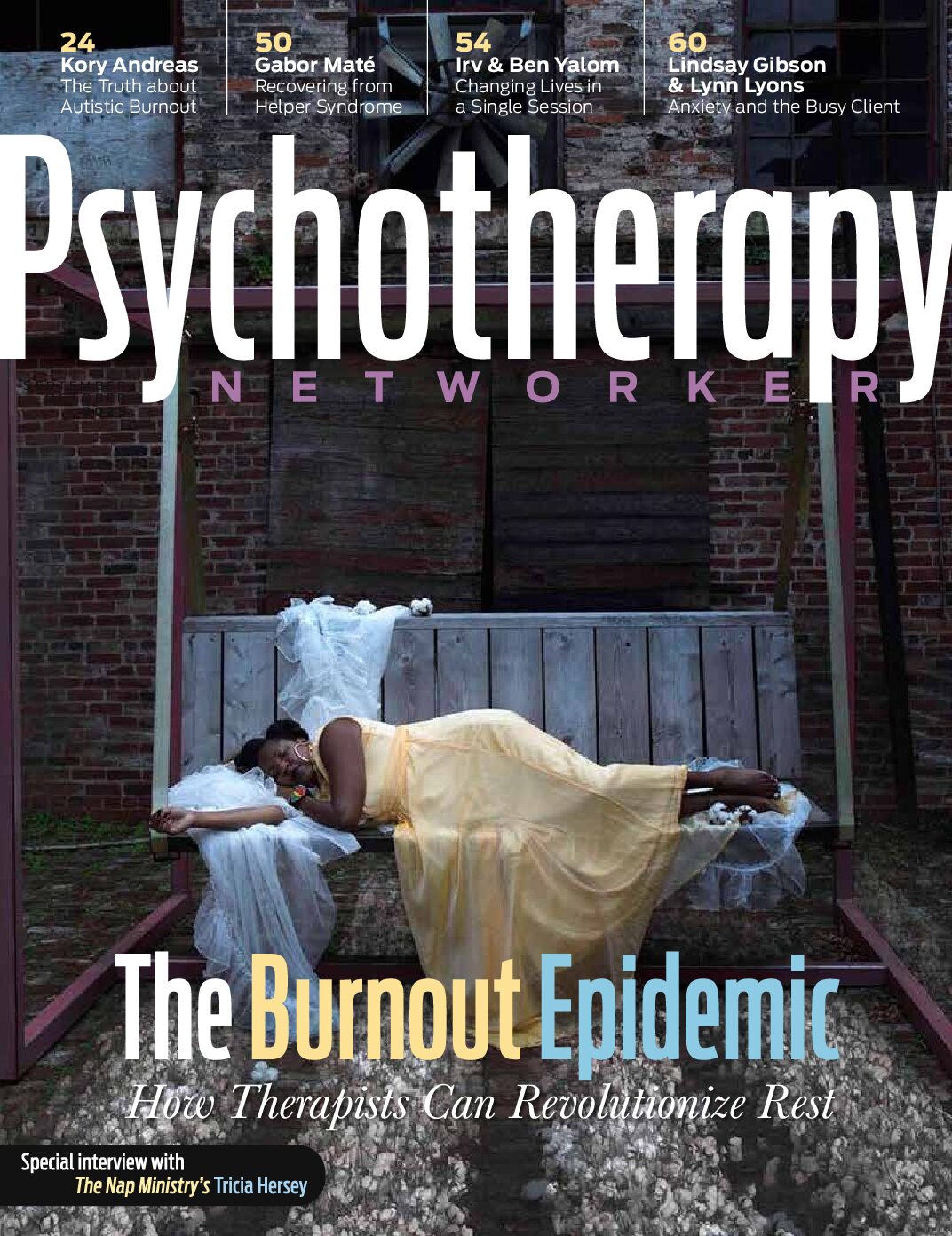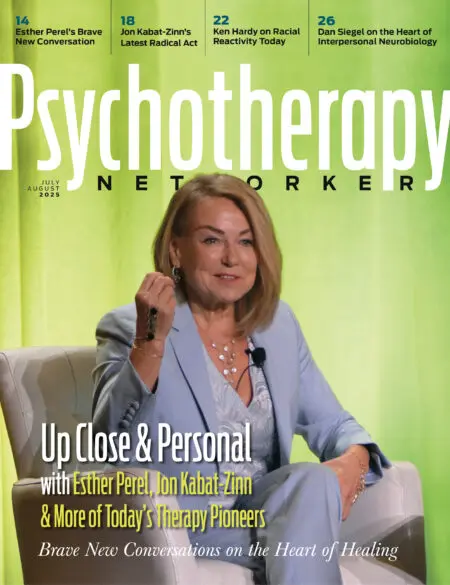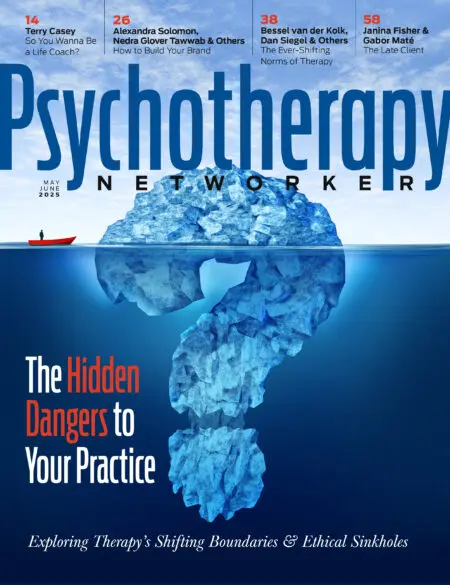Several years ago, while in graduate school in New York, I attended a lecture by a famous psychoanalyst who was advocating for a special place for psychoanalysis in today’s society. The world, he argued, has become too fast paced and goal oriented. People are pushed into acting without thinking, behaving without contemplating, and are leading overly productive lives. In fact, he suggested that Nike’s advertising slogan—“Just Do It”—best symbolizes our time.
“Nike-ism,” he argued, “is everything that psychoanalysis is not.” And our duty as therapists is to preserve the countercultural force of psychotherapy opposing this tide—against rushing and doing too much and thinking too little.
“Well,” I told my friend as we listened to the enthusiastic applause of the audience. “I kinda like that slogan.”
“Why?” she asked.
“Look at this room!” I answered. “Everything is so slow, so predictable. Don’t you think analysts need to hurry up sometimes? Get a kick to their backside on occasion? Otherwise, it can all become a grand festival of nodding and sighing and snoozing. I don’t think psychotherapy is about that at all.”
The dichotomy between doing and being is central to the way therapists view psychotherapy, both as a special practice in the world and as a helpful way to distinguish between different types of therapy: between the more concrete, results-driven types and the slower, more contemplative ones.
I was first taught this distinction as a contribution of Donald Winnicott, who perceived “being” as a special manner in which analysts are present in the room, one that allows patients to open up, to freely associate, and to delve deeper into their experiences and their meaning. The uncle in the funeral who’s constantly moving around and asking how he can be helpful is in a doing state, our professor told us; the friend who’s sitting in silence and holding the bereaved person’s hand is being.
Throughout my training and career, being was held as an ideal of psychotherapy. Let everyone else be obsessed with results and achievements; therapy will stand in its unique position as a bastion of a different, quieter kind of presence, a promise to stop time and create a space unlike any other in modern society.
But what happens when therapists actually need to do something? Like building a large publicly funded treatment and training center from scratch?
After a long period in New York, I returned home to Israel, relearned doing therapy in Hebrew, and readjusted myself to the Middle East, which mostly meant answering questions about why I was dressed in a button-down shirt all the time. “Are you going to a wedding later?”
Then, three years ago, I became the clinical director of Headspace in Jerusalem. Originally from Australia, it’s an organization that provides tailored and holistic mental health support and early intervention to young people, 12 to 25 years old. Our main clinical service is focused and brief psychotherapeutic interventions.
After a year of preparation, I was able to recruit four therapists. In two years, we grew to a team of 20 therapists, supervisors, and students-in-training, and we treat about 500 young people annually. In other words, we worked in a hurry.
Throughout these two years, we’ve encountered innumerable dilemmas and challenges, points of friction and disagreement, and a general question that’s been hovering over us: how do you create a great training culture, one in which therapists become substantially better at what they do?
Vision vs. Reality
If someone asks me (and sometimes people do) about my clinical vision for our center, I say that therapists are much more important than the model they practice, that they need real feedback (including metrics) about their work, and that the treatment approach should be personalized and tailored to the specific patient. And, importantly, the main focus of training and improvement should be the cultivation of therapists’ core abilities and skills, rather than reliance on specific models. To me, our theoretical approach as a large publicly funded center should be “whatever works,” prioritizing clinical outcome over anything else.
Nice vision, perhaps, but the problem is that most of the therapists I’ve met, in Israel as well as the US, don’t believe in it. Instead, the buzzword around the clinic seems to be professional. If we’re learning a particular model or intervention, if we’re reading a complicated psychodynamic article, if we’re learning theory—we are being professional. If we’re not doing any of that—we are not. And not being seen as such, especially for a young center like ours, headed by a clinical director in his 30s, feels scary. What will the adults (the established clinical places in the city) think of us?
Despite growing evidence that questions the presumed differences between therapeutic modalities, we’re still, I think, very much in the model-specific era of psychotherapy. So when someone is presenting a case at Headspace, the comments about how a therapist listens, connects, challenges, uses her tone of voice are generally perceived as less interesting and shallower than a sophisticated interpretation based on a theory or a particular model. This happens regularly, even though many people, myself included, believe that these intangibles (or common factors, as they’re known) affect psychotherapeutic outcomes more than anything else.
Luckily, we’re not the first ones to struggle with this challenge. One of the leaders in the focus on common factors and the application of outcome metrics and feedback in psychotherapy is Robbie Babins-Wagner from the Calgary Counselling Centre. I was fortunate to meet her in person and learned two vital things from her: implementing an outcome-based approach in a clinical center takes many years, and most therapists will be against it.
Often, an approach that’s seen as results driven can be perceived by therapists as cold and mechanical, something the “management” is doing for ulterior motives (funding) while overlooking the humanity and individuality of psychotherapy (the “being” element), which is the very thing that drives change and motivates people to work as therapists. My challenge, and my role as a clinical director, is to persuade people that this is not so. I aim to show that by implementing a skill-specific, outcome- and feedback-driven approach, we’re actually prioritizing the human, intricate, unique aspects of psychotherapy and giving them center stage.
I was never trained to implement this approach myself, but I’ve realized that this is precisely what was missing in my otherwise diverse and enriching education. So I understood that I needed to start slowly, in increments. For instance, when therapists at the clinic were against using recordings for feedback (out of a concern for patients’ privacy and therapists’ fear of being exposed) I introduced it first to students in training, who started to record their sessions for supervisory purposes so they could share their impressions about doing it with the team. When a plan that included an outcome questionnaire after every session was seen as cumbersome (“What are we even learning with these basic questions? They tell us nothing about what’s actually going on in the room”), we went with shorter and temporarily less frequent questionnaires.
I’m not trying to convince anyone that a questionnaire can replace a sophisticated, human perception of the psychotherapeutic process—only that it can add something to it. As we know, implementing change takes time and trusting relationships.
Fast vs. Slow
Therapy requires a pause, a space for reflection; and frequently, that means resisting the urge to act. In my experience, most therapists expect a working environment that allows and promotes a slow pace and opportunities for deep contemplation that aren’t restricted to specific goals and results.
Our center grew fivefold in two years. In Jerusalem, the demand for free psychotherapy far exceeds the supply, with an average waiting time for individual sessions being around six months. Therefore, our goal, duty, and part of our ethos at Headspace is to make therapy accessible to all in the shortest time possible. So our pace has in fact been very “Nike-y,” and we’ve expanded quickly.
Naturally, the fast growth and the culture associated with it have created much tension and disrupted ideal working conditions for most therapists. Every new therapist that I presented to the team (at some point, almost every other month) was met with the same reaction from the staff: we’ve just gotten to know each other; you promised that you’ll finally slow down. To be at our best, the therapists complained, we need to feel some stability and continuity, not be rushed and confronted with change all the time.
It took me time to understand how important it is to shield therapists from the business demands and the “start-upy,” quick-paced nature of our center. I banged my head more than once in trying to convince people that we must be fast, that we have to introduce new programs that meet our community’s needs, that to significantly cut waiting time (which we did) we need to be efficient and quick. I spent countless team meetings trying to explain my position and the critical part of efficiency and agility in an organizational strive for excellence. I (and my colleagues still laugh at me for it) often used words like greatness, (as it is, in English, while talking in Hebrew)—until I realized that I didn’t have to do that.
Today, I think the best clinical centers have two parallel paces: they’re fast and slow at the same time. Outside the room, they’re fast when they create new programs, partner with other organizations, and continually try to improve the service experience of clients. But they’re slow inside the room, in seminars and group consultations. They take their time when thinking about patients and their struggles. I’ve come to think of the therapists’ “slowness” not as a predicament, but as a boon and a sign of good therapy.
The work on the fast vs. slow dilemma is, in my opinion, a work of separation and individuation: separating the operational, business part from the clinical part and enhancing both, individually and separately. Many organizations where I’ve worked mix and confuse the two. This is how a place becomes inefficient: everything is either psychodynamic and processed and talked about to no end (including the operational side), or shallow because the focus on efficiency pervades the therapy room and makes it feel a little dumb. A good center needs both qualities to exist at the same time; the dual pace allows it to be both efficient and deep.
Authority vs. Egalitarianism
It’s safe to say that psychotherapy has become much less authoritarian since its inception as a medical service provided by physicians in Europe in the late 19th century. Therapists nowadays see themselves less as experts providing treatment to passive patients, and more as equal collaborators in a relational process. This change requires therapists to deal with questions of authority and expertise. In a collaborative process, what exactly is it that we therapists are experts on? And what is the source of our authority?
These questions are relevant not only in the room, but also outside of it—in graduate schools, training facilities, and clinics. I’ve been thinking quite a bit about my role as a clinical director in terms of implementing authority on the way we work with, and think about, patients. Once again, it seems to me that we face two opposing needs here. The therapists need guidance and a clear definition of what it is that we’re doing—what kind of psychotherapy we practice, and what we consider a success. In contrast, they also need freedom to be the best clinicians they can be—to bring their individuality, creativity, and humanity to the room. You can’t really tell someone how to do therapy; you can only suggest a direction.
In addition, a good clinical center has to have an atmosphere that promotes camaraderie, a sense of ease between people, and a joy in being part of a group and an organization. It trickles down to the treatments themselves and to the way therapists discuss cases and seek consultation from one another. But what happens when leadership and staff have sharply different ideas about the clinical direction, the nature of the work, and the priorities of the clinic? It seems to me that such situations are commonplace, and this has definitely been true at Headspace.
Take the issue of supervision. Remembering my own experience, I wanted to provide a different model of supervision, one that operated on an as-needed basis. I‘d struggled in my own training with the tedious re-creation of sessions every week, which had felt ineffective and boring. I’d imagined that probably everyone felt that way in training. But I was wrong. It took several months of arguments between me and the therapists until I realized that my position had been an empathic failure: I’d failed to understand that they needed something other than what I did—that to feel safe and competent, they needed the weekly holding environment of supervisors. Realizing that, I switched to the more classic, regularly scheduled form of supervision, which enhanced our mutual trust. The therapists felt heard and respected, and the authority over best practice was mutual and shared.
I think a similar process of diffusion of authority is present in our clinical seminars. Most therapists come to Headspace with significant skepticism about the brief therapy model and its possibilities. My reaction to that in the beginning was to double down on the merits of our model in a car-salesman kind of way, promising too much. With time, I realized that not only is it beneficial for our discussions to allow for skepticism, it’s a more efficient way to convince people that we’re doing something worthwhile. Only by allowing a critical, open discussion—in which everyone’s an expert—can the group come to see the value of its own work.
Therapists, by and large, are not binary creatures: they value nuance and allow for complications. So, in our discussions, we’ve come, gradually, to appreciate differences of opinion. As people have become more comfortable with each other and more secure in their therapeutic work, they’ve also become more open. This is true of me as well: as I’ve become more secure in my position as a director, I’ve become less pushy. I’m trying to present my ideas with more humor and less certainty, while allowing a dialogue with opposing views. But I’ve never changed my mind about the crucial elements: the spirit of the place has to be productive and joyful, and therapy, more than anything else, has to be a humanistic endeavor, in which the therapists’ originality and creativity are the main factors of change.
Individuality vs. Cohesion
Adding to my belief—and sustained by a growing body of research—in the therapists’ characteristics as the crucial element of change in psychotherapy is a belief in matching therapists and patients. While great therapists can usually work with a diverse population of patients, even the best ones do better with some patients and not others.
We’ve recruited therapists from almost all available therapeutic professions: clinical psychology, social work, neuropsychology, art therapy, and so on. They’re all expected to do the same work—primarily individual and group psychotherapy—but each with a different emphasis. Despite some resistance in the beginning, therapists at Headspace accepted the model I proposed, in which the person who performs the intake is encouraged to think about a person in the team who will be most appropriate to work with the patient. And I believe that the best way to ensure a good match is simply to get to know your colleagues.
To some people at Headspace, this method at first seemed a little self-indulgent, stemming from the belief that public community centers like ours should be able to work with everyone. And this is certainly what I was used to in every public clinic I’d trained in: I’d just gotten whoever was assigned to me, sometimes even before I’d started working and people knew who I was. However, I believe that a more intuitive method of matching is actually the best way to elevate the level of service and our clinical work.
Such a method, I believe, allows for real diversity in clinical staff. Not everyone is equally good at everything: some therapists are better with concrete, exposure-based work on anxiety; others are experts with patients with health disorders; still others are great with younger patients who are less verbal. Our patient-based approach, together with a diverse group of therapists, allows us to tailor an appropriate intervention, provided by a therapist who is comfortable with it, to a specific patient who needs it. The cohesive part then becomes the common factors that should be shared among therapists: the ability to form and maintain a relationship, an empathic understanding, the use of humor and self-disclosure, the ability to provide hope, and so forth. The way each therapist does it in the room is individual and unique.

The reason I like the Nike slogan—“Just Do It”—is because I think that in some clinical circumstances, being active is the deepest and most appropriate way to be. As a therapist, I always tried to combine different approaches and rejected the wars between modalities. I found that for some patients, active behavioral interventions—even in the midst of a psychodynamically informed treatment—were often the best, most empathic, interventions. Today, as the clinical director of a center that tries to be patient centered, I believe this even more strongly—that, at times, action trumps reflection, and making someone move might be the best thing we can offer. At the clinic, we’re trying to combine being with doing, efficiency with depth, agility with contemplation. Sometimes we fail—but sometimes, when we’re lucky, we’re just able to do it.
PHOTOS © ISTOCK/PEPIFOTO
Valery Hazanov
Valery Hazanov, PhD, holds a doctorate in clinical psychology from Columbia University. He’s the clinical director of headspace Jerusalem, a public psychology treatment center.













